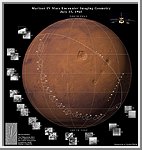
Courtesy of the Jet Propulsion Laboratory and NASA's National Space Science Data Center
Mariner 4 was the fourth in a series of spacecraft used for planetary exploration in a flyby mode. It was designed to conduct closeup scientific observations of the planet Mars and to transmit these observations to Earth. Mariner 4 gave scientists their first glimpse of Mars at close range, passing over the planet at an altitude of 9,846 kilometers (6,118 miles) above the surface and putting to rest the myths of the late 19th century that the planet might have harbored an advanced civilization. Launched on November 28, 1964, Mariner 4 carried a television camera and six other science instruments to study interplanetary space between the orbits of Earth and Mars and in the vicinity of Mars itself. After 7.5 months of flight, the spacecraft flew by Mars on July 14, 1965, and returned 22 television pictures covering about 1 percent of Mars's surface. The pictures revealed a vast, barren wasteland of craters strewn about a rust-colored carpet of sand. The canals that Percival Lowell had spied with his telescope in 1890 proved to be an optical illusion, but natural waterways of some kind seemed to be evident in some regions of the planet. Other experiments measured atmospheric density and the interplanetary medium.
Once past Mars, Mariner 4 journeyed on to the far side of the Sun before returning to the vicinity of Earth again in 1967. Nearly out of power by then, engineers decided to use the aging craft for a series of operational and telemetry tests to improve their knowledge of the technologies that would be needed for future interplanetary spacecraft. All operations of the spacecraft ceased on December 20, 1967.
 Mariner 4
Mariner 4
Mariner 4 was launched November 28, 1964, on a 228-day mission to Mars.
The spacecraft passed Mars at a distance of 9,868 kilometers (6,118
miles), recording and transmitting to Earth the first close-up picture
of the red planet. In 22 pictures, Mariner's TV camera scanned about
one percent of the Martian surface, revealing ancient craters of varying
size.
(Courtesy NASA/JPL)
 Mariner IV Mars Encounter Imaging Geometry
Mariner IV Mars Encounter Imaging Geometry
Mariner IV was the fourth in a series of spacecraft used for planetary exploration
in a flyby mode and the first spacecraft to succesfully image a planet. It was
launched on 28 November 1964 by an Atlas/Agena rocket and flew by Mars on July 15,
1965.
The total data returned by the mission was 5.2 million bits including 21 pictures
plus 21 lines of a 22nd picture and took more than a week to transmit to earth
with the 8.33 bps transmission rate of the spacecraft. The images returned showed
a Moon-like cratered terrain (which later Mariner IX showed was not typical for
Mars, but only for the more ancient region imaged by Mariner IV). Though not as
good looking as images returned by later missions these 22 images are mankind's
first images taken by a planetary spacecraft and have great historical value.
(Courtesy A. Tayfun Oner)

 Space History
Space History